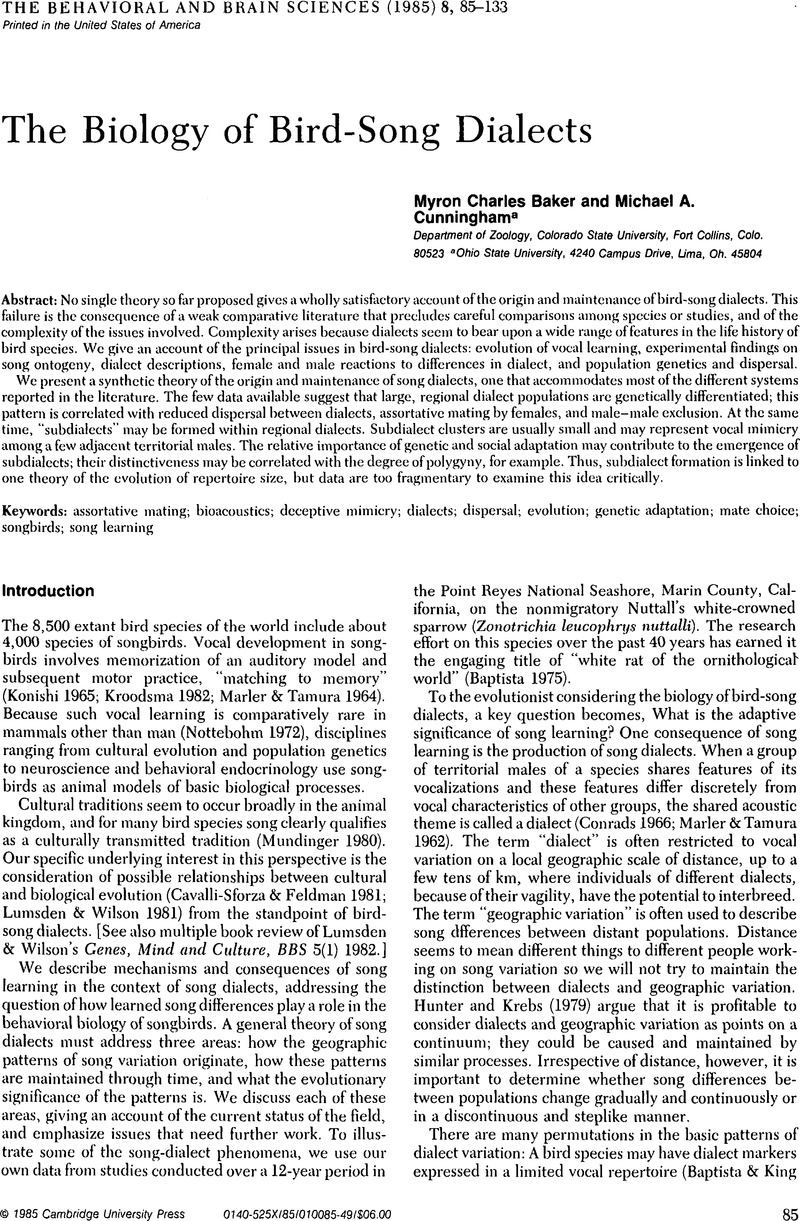Crossref Citations
This article has been cited by the following publications. This list is generated based on data provided by Crossref.
Baptista, Luis F.
and
Petrinovich, Lewis
1986.
Song development in the white-crowned sparrow: social factors and sex differences.
Animal Behaviour,
Vol. 34,
Issue. 5,
p.
1359.
Petrinovich, Lewis
and
Baptista, Luis F.
1987.
Song development in the white-crowned sparrow: modification of learned song.
Animal Behaviour,
Vol. 35,
Issue. 4,
p.
961.
Jensen, Donald D.
1988.
The polythetic perspective.
Behavioral and Brain Sciences,
Vol. 11,
Issue. 4,
p.
637.
Kruijt, Jaap P.
and
ten Cate, Carel
1988.
Song development and sexual imprinting: Toward an interactionist approach.
Behavioral and Brain Sciences,
Vol. 11,
Issue. 4,
p.
640.
MCGREGOR, PETER K.
WALFORD, VERENA R.
and
HARPER, DAVID G.C.
1988.
SONG INHERITANCE AND MATING IN A SONGBIRD WITH LOCAL DIALECTS.
Bioacoustics,
Vol. 1,
Issue. 2-3,
p.
107.
Khayutin, S. N.
and
Alexandrov, L. I.
1988.
Ab ovo with song?.
Behavioral and Brain Sciences,
Vol. 11,
Issue. 4,
p.
637.
Burghardt, Gordon M.
1988.
Developmental creationism.
Behavioral and Brain Sciences,
Vol. 11,
Issue. 4,
p.
632.
Hirsch, Jerry
1988.
Behavior-genetic analysis versus ontogenetic imperialism.
Behavioral and Brain Sciences,
Vol. 11,
Issue. 4,
p.
635.
Dehaene, Stanislas
and
Changeux, Jean-Pierre
1988.
Selectionist mechanisms: A framework for interactionism.
Behavioral and Brain Sciences,
Vol. 11,
Issue. 4,
p.
633.
Lemon, R. E.
1988.
Birdsong development: Real or imagined results?.
Behavioral and Brain Sciences,
Vol. 11,
Issue. 4,
p.
640.
Mundinger, Paul C.
1988.
Conceptual errors, different perspectives, and genetic analysis of song ontogeny.
Behavioral and Brain Sciences,
Vol. 11,
Issue. 4,
p.
643.
Kroodsma, Donald E.
1988.
Behavioral ontogeny research: No pain, no gain?.
Behavioral and Brain Sciences,
Vol. 11,
Issue. 4,
p.
639.
King, Andrew P.
and
West, Meredith J.
1988.
Ducks don't sing.
Behavioral and Brain Sciences,
Vol. 11,
Issue. 4,
p.
638.
Steklis, Horst D.
1988.
The nature/nurture debate: Same old wolf in new sheep's clothing?.
Behavioral and Brain Sciences,
Vol. 11,
Issue. 4,
p.
649.
Searcy, William A.
1988.
Song development from evolutionary and ecological perspectives.
Behavioral and Brain Sciences,
Vol. 11,
Issue. 4,
p.
647.
Konopka, Ronald
1988.
When is developmental biology not developmental biology?.
Behavioral and Brain Sciences,
Vol. 11,
Issue. 4,
p.
639.
Johnston, Timothy D.
1988.
Developmental explanation and the ontogeny of birdsong: Nature/nurture redux.
Behavioral and Brain Sciences,
Vol. 11,
Issue. 4,
p.
617.
Slater, P. J. B.
1988.
The nature and nurture of birdsong.
Behavioral and Brain Sciences,
Vol. 11,
Issue. 4,
p.
648.
Pepperberg, Irene M.
1988.
Nature/nurture reflux.
Behavioral and Brain Sciences,
Vol. 11,
Issue. 4,
p.
645.
Morton, Eugene S.
1988.
‘Innate’: Outdated and inadequate or linguistic convenience?.
Behavioral and Brain Sciences,
Vol. 11,
Issue. 4,
p.
642.





